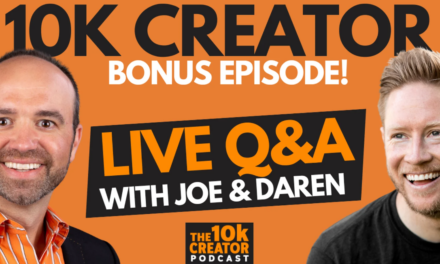Whether you’re just starting a content business or are deep into it, knowing what is working with your content and what isn’t is critical in order to know where to put your efforts. Data can help you find those insights to ensure that your time is being used most effectively.
How can I use my data?
The endgame with your data is to track metrics that let you know how your content is performing against your strategic objectives. If you don’t have your business strategies clearly defined, looking at your data isn’t going to help determine if you’re meeting your goals.
Data endgame for creators? Track metrics to see how content performs against strategic objectives, says @BrianwPiper. #ContentEntrepreneur #CreatorEconomy Share on XSo, start with clearly defined goals. For example, if your goal is to convert 10% of your social followers to paying customers, looking at your site’s page views in Google Analytics won’t help determine your progress. You have to know your goals before your data is useful.
Where do I start with my data?
Start with the obvious, measurable elements. Sometimes referred to as “vanity metrics,” these are the easiest places to start. In Google Analytics, these include page views, time on site, bounce rate, etc. In social media, these are followers, impressions, likes, etc. In newsletters, it’s open rates, click rates, etc. It’s really all the easy-to-find metrics on the platform where your content lives.
These metrics may not provide the most impactful information on your content, but you should track them. They can get you using your analytics platforms regularly and provide some low-hanging fruit that can turn into big wins.
However, it’s not enough to just look at those metrics. You need to document them. Start a spreadsheet and add those metrics each week. If you have historical data in your analytics accounts, add the data from a few weeks or months earlier.
It's not enough to look at your metrics. Document them so you can see how they evolve week over week, advises @BrianwPiper. #CreatorEconomy #ContentEntrepreneur Share on XWith this basic metric tracking in place, you can start determining what other metrics to track, goals to set, and where efforts should be directed. Add elements into your tracker that the analytics don’t tell you. For example, is your post about a particular topic? Does it include an image? Is it a video? Does it relate to a particular strategic initiative?
“The thing that a lot of people don’t do is take into account what is in the content itself… and then doing some analysis, even just in an Excel spreadsheet, just with your basic correlation function to say, ‘Do any of these things matter specific to the audience that we’re after?’” – Chris Penn, Trust Insights
Look at metrics and ask: "Do any of these things matter to the audience we're after," says @CsPenn via @BrianwPiper. #Analytics #AudienceBuilding #CreatorEconomy Share on XWhere do I find insights in my data?
Your data-informed insights will come from looking for trends and anomalies. The most effective way is to look at the data over time. If you have a year’s worth of data, look at the entire year. Look for patterns or extreme highs or lows. These insights can scrutinize other potentially related metrics or delve deeper into the causes of the anomaly.
Caveat: Don’t spend all your time collecting data without looking for the insights. That’s where the magic happens.
If your goal is to build brand awareness by doubling your audience on a social platform, look for growth spikes in the number of followers in the previous year. Try to identify the posts or actions that correspond to that time. Was there a singular topic or area of focus? Did you use particular hashtags or mentions that drove engagement? What were the comments focused on? Look for opportunities to replicate those types of posts and see if that has the same effect.
How do I start a deep dive into my analytics?
Once you start tracking and analyzing your data, you’ll see other pieces of information that would be helpful. The exact data that lead to your biggest insights will depend on your goals, your channels, and your ability to look at several factors at once. You may need to use other analytics tools to track the metrics you want.
Using the earlier example, if you were trying to convert 10% of your social followers to paying customers, you could use UTM codes on your social post links to track traffic coming from those pages. Set up goals in Google Analytics to follow those campaigns through to a purchase.
Use UTM codes in your social post links to track traffic coming to your website from those pages, says @BrianwPiper. #ContentEntrepreneur #ContentBusiness Share on XTo dive deeper into this, and get more insights, look at the data within your social media accounts to identify high-engagement posts and cross-reference the dates of those posts with conversions on your site. If particular posts drive traffic to the site and convert those visitors, those are the ones to promote or on which new posts should be modeled.
What analytics do I track in Web3?
The Web3 landscape is developing and evolving every day. As creators looking to grow the creator economy, we need to track growth and performance across our content channels. We also need to track community growth since our community is the key to our success. You need to know what actions create a larger community, which channels drive converts a visitor to a community member, and which conversations create the most engagement.
In #Web3, creators should track community growth to see what actions create a larger group and which conversations create the most engagement, says @BrianwPiper. #ContentEntrepreneur Share on XLook at your community data to identify spikes in new members and try to correlate that to posts or content that encouraged users where to find your community. Do you see a spike each week when you send your newsletter that has the link to your Discord channel at the bottom? Were you on a Twitter Space that drove new members? Even better, just ask your users how they discovered your community but realize that many of your users may not remember where they found you.
Reviewing your data is key to creating effective content
Whether you’re blogging, tweeting, podcasting, or building a community, consistently looking at your data will help you figure out the best place to spend your time to ensure the greatest results from your efforts.
Brian will be speaking at Creator Exconomy Expo in May. His session Using Data to Optimize Content is not to be missed. Register today!
About the author
Brian Piper is Director of Content Strategy and Assessment for the University of Rochester Department of Communications. Brian has been doing SEO and content strategy since 1996. He has created online training programs for hundreds of companies including Xerox, Carestream, Kodak, and Volvo. He has spent the last seven years focusing on data analytics, content marketing, and strategy. When he's not creating data visualizations, he teaches wingsuit skydiving and spends time with his wife and six children.










